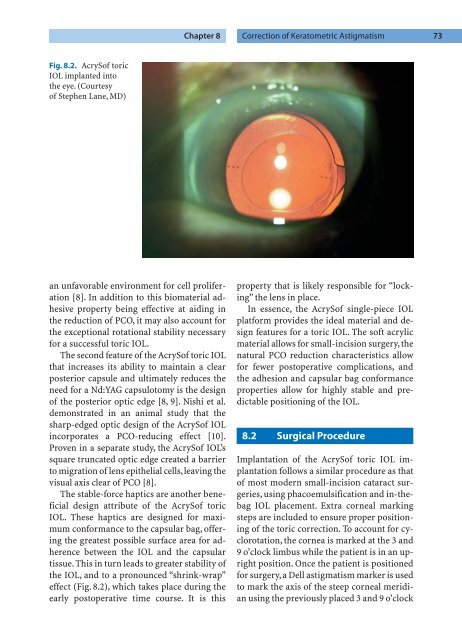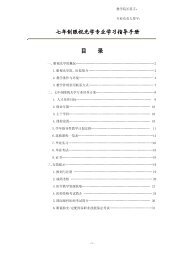Refractive Lens Surgery
Refractive Lens Surgery
Refractive Lens Surgery
Create successful ePaper yourself
Turn your PDF publications into a flip-book with our unique Google optimized e-Paper software.
Fig. 8.2. AcrySof toric<br />
IOL implanted into<br />
the eye. (Courtesy<br />
of Stephen Lane, MD)<br />
an unfavorable environment for cell proliferation<br />
[8]. In addition to this biomaterial adhesive<br />
property being effective at aiding in<br />
the reduction of PCO, it may also account for<br />
the exceptional rotational stability necessary<br />
for a successful toric IOL.<br />
The second feature of the AcrySof toric IOL<br />
that increases its ability to maintain a clear<br />
posterior capsule and ultimately reduces the<br />
need for a Nd:YAG capsulotomy is the design<br />
of the posterior optic edge [8, 9]. Nishi et al.<br />
demonstrated in an animal study that the<br />
sharp-edged optic design of the AcrySof IOL<br />
incorporates a PCO-reducing effect [10].<br />
Proven in a separate study, the AcrySof IOL’s<br />
square truncated optic edge created a barrier<br />
to migration of lens epithelial cells,leaving the<br />
visual axis clear of PCO [8].<br />
The stable-force haptics are another beneficial<br />
design attribute of the AcrySof toric<br />
IOL. These haptics are designed for maximum<br />
conformance to the capsular bag, offering<br />
the greatest possible surface area for adherence<br />
between the IOL and the capsular<br />
tissue. This in turn leads to greater stability of<br />
the IOL, and to a pronounced “shrink-wrap”<br />
effect (Fig. 8.2), which takes place during the<br />
early postoperative time course. It is this<br />
Chapter 8 Correction of Keratometric Astigmatism 73<br />
property that is likely responsible for “locking”<br />
the lens in place.<br />
In essence, the AcrySof single-piece IOL<br />
platform provides the ideal material and design<br />
features for a toric IOL. The soft acrylic<br />
material allows for small-incision surgery, the<br />
natural PCO reduction characteristics allow<br />
for fewer postoperative complications, and<br />
the adhesion and capsular bag conformance<br />
properties allow for highly stable and predictable<br />
positioning of the IOL.<br />
8.2 Surgical Procedure<br />
Implantation of the AcrySof toric IOL implantation<br />
follows a similar procedure as that<br />
of most modern small-incision cataract surgeries,<br />
using phacoemulsification and in-thebag<br />
IOL placement. Extra corneal marking<br />
steps are included to ensure proper positioning<br />
of the toric correction. To account for cyclorotation,<br />
the cornea is marked at the 3 and<br />
9 o’clock limbus while the patient is in an upright<br />
position. Once the patient is positioned<br />
for surgery,a Dell astigmatism marker is used<br />
to mark the axis of the steep corneal meridian<br />
using the previously placed 3 and 9 o’clock



